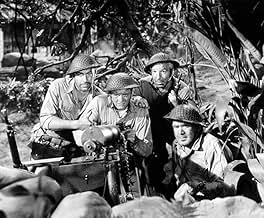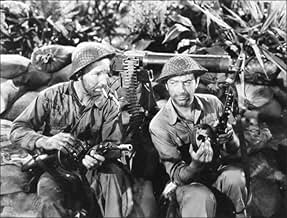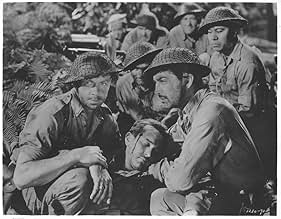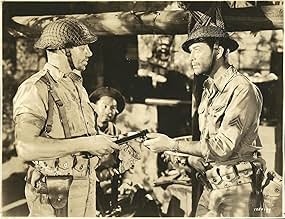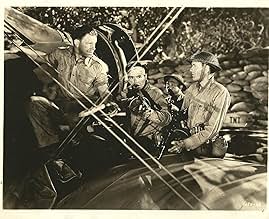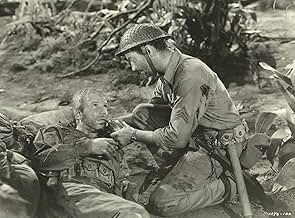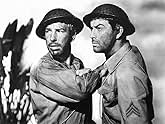Aggiungi una trama nella tua linguaIn 1942, in the Bataan peninsula of the Philippines, a ragtag American unit commanded by Sergeant Bill Dane attempts to blow-up a bridge in order to slow the Japanese advance.In 1942, in the Bataan peninsula of the Philippines, a ragtag American unit commanded by Sergeant Bill Dane attempts to blow-up a bridge in order to slow the Japanese advance.In 1942, in the Bataan peninsula of the Philippines, a ragtag American unit commanded by Sergeant Bill Dane attempts to blow-up a bridge in order to slow the Japanese advance.
- Regia
- Sceneggiatura
- Star
- Premi
- 5 vittorie totali
- Yankee Salazar
- (as J. Alex Havier)
- Wounded Soldier
- (non citato nei titoli originali)
- Japanese Soldier
- (non citato nei titoli originali)
- Japanese Soldier
- (non citato nei titoli originali)
- Infantry Soldier
- (non citato nei titoli originali)
Recensioni in evidenza
NOTE: A previous persons comment stated that they were not even wearing American helmets. In fact, the helmets worn in the movie ARE correct for the American Army in the early 1940's.
The jungle setting (although filmed on the studio lot) is impressive with its exotic foliage and adds to the realism. The hand to hand combat scenes are well staged, as are the final moments of the film.
All in all, a gripping war film that more than holds its own with contemporary stories like SAVING PRIVATE RYAN.
Has to be appreciated in the context of its time--when flag-waving patriotism was at its peak and lines like "Those dirty Japs" were not considered politically incorrect.
Lets get the complaints of others out the way first. Yes this is a studio shot production, yes there is model work involved, and yes this is unashamedly a flag waving, chest thumping, rally call of heroism. Based around actual events, this is a fictionalised telling that also has no shame in being disparaging towards the Japanese in the film. Now are these things really a problem? This is after all 1943, a time when the US was struggling in the Pacific conflict. A loose copy of John Ford's 1934 film The Lost Patrol, Bataan served as a moral booster for the public back home. The message is clear, this may be tantamount to a suicide mission, because, well, war is indeed hell, but sacrifices are necessary to achieve the bigger freedom objective.
Nicely directed by Tay Garnett {The Postman Always Rings Twice} and tightly scripted by Robert Hardy Andrews {The Cross of Lorraine}, the film stars Robert Taylor, George Murphy, Thomas Mitchell, Robert Walker, Desi Arnaz & Lloyd Nolan. Violent and brutal for its time {the hand to hand bayonet sequences are brilliantly realised}, Bataan is also notable for portraying a racially integrated fighting force having to come together for the greater good. This group of men are a mixed bunch, different backgrounds, different races and different classes. But they are in the same boat as the Japanese start to pick them off one by one, and not only that, but Malaria is in the camp as well. The tension is racked up, the atmosphere stifling, we the viewers are witness to a unique show of heroism as we live with these men during their last soul sapping days.
The cast do really well when one considers they are in fact playing disposable characters. Taylor in particular is effective as the tough Sergeant forced into command of the group. While some scenes such as a moodily staged camouflaged Japanese approach are truly memorable and linger long in the memory. The end also is terrific, one which puts one in mind of Sam Peckinpah watching and nodding approvingly. High on suspense and beating a real brave heart, Bataan is up with the best that the war genre of film has to offer. Belyng its budget restrictions it achieves its aims and then some. 8.5/10
Yes, you can say some of the soldiers are clichéd, but death is shown unflinchingly. Combat is portrayed as a bloody, messy, fatigue-inducing business. Boredom and endless waiting take their toll on nerves as well. The banter and cocky talk is whistling past the graveyard.
Lloyd Nolan's character is rough and unlikeable. He fights for freedom, but he fights dirty and he doesn't pretty things up with patriotic speeches. Some might complain about the black soldier playing harmonica and taking orders from white men. Actually, for the time, he was portrayed with dignity and shown to be as brave as any of the other soldiers. As for Robert Taylor, his weariness and resolve at the end are stirring and the last scene is not one you will soon forget.
Ignoring the propaganda aspects of the movie, the last half works as almost a pure horror movie, as our cast gets gruesomely picked off by unseen foes lurking in the jungle.
Exciting and gripping, it's easy to overlook the faults of this most violent and gritty of WW2 films made at the time.
"Bushido, Bushwa! You stink!" So died the heroes of Bataan...
This classic warlike movie is nicely starred by Robert Taylor at one of his best roles as a tough sergeant , he's accompanied by a plethora of first-rate secondaries . This exciting actioner warfare completed with slice of military stereotypes although some characters are very one-dimensional , as well as presenting an African American in an intelligent and sympathetic manner , attempting to avoid any racial speeches in the script . The original plot belongs to ¨Lost patrol¨ (1934) by John Ford , whose screenplay has been pretty imitated and remade many times but it's still a magnificent entertainment . In fact , Metro-Goldwyn-Mayer paid RKO a lot of money for the right to use scenes from Lost patrol in this movie . As ¨Lost patrol¨ was subsequently remade and reworked several times : ¨Sahara¨ (by Zoltan Korda) with scenarios in Libya desert ; ¨Last of Comanches¨ (Andre De Toth) in California desert ; and even part of ¨Flight of Phoenix¨ (Robert Aldrich) in Sahara desert , and , of course , this ¨Bataan¨(Tay Garnett) in Philippines jungle . This is one of a handful of feature films that have featured the story of the World War II Battle of Bataan , they include ¨So proudly we hail¡¨ by Mark Sandrich (1943) ; ¨They were expendable¨ (1945) by John Ford and ¨Back to Bataan¨ (1945) by Edward Dmytryck . The film is set into a lush , abundant jungle with a dense fog made by usual Metro Goldwin Mayer production designer , Cedric Gibbons , and it contains an atmospheric as well as thrilling musical score by Bronislau Kaper . The motion picture was professionally directed by Tay Garnett, a good Hollywood craftsman.
The actual deeds about Bataan concern an unsuccessful attempt by US and Filipino troops under General Douglas MacArthur to defend the peninsular against the Japanese 1 Jan-9 April 1942 . Following the surrender of Bataan , MacArthur was evacuated , but Allies captives were force-marched 95 km/60 mi to the nearest railhead in the Bataan Death March,ill-treatment by the Japanese guards during the march killed about 16.000 US and Filipino troops .
Lo sapevi?
- QuizPrologue: "When Japan struck, our desperate need was time--time to Marshall our new armies. Ninety-six priceless days were bought for us--with their lives--by the defenders of Bataan, the Philippine army which formed the bulk of MacArthur's infantry fighting shoulder to shoulder with Americans. To those immortal dead, who heroically stayed stayed the wave of barbaric conquest, this picture is reverently dedicated."
- BlooperAlthough the American soldier was clearly a great coconut tree climber, it is near to impossible to sit atop a coconut tree. Many Filipinos to this day fall when attempting this.
- Citazioni
Sergeant Bill Dane: Come on, suckers! What's the matter with you? What are you waitin' for? Didn't think we were here, did you? You dirty rotten rats! We're still here! We'll always be here! Why don't you come and get it?
- Curiosità sui creditiClosing credits epilogue: So fought the heroes of Bataan. Their sacrifice made possible our victories in the Coral and Bismark Seas, at Midway, on New Guinea and Guadalcanal. Their spirit will lead us back to Bataan!
- Versioni alternativeAlso available in a computer colorized version.
- ConnessioniFeatured in Toast of the Town: A Salute to Lucy and Desi (1954)
- Colonne sonoreSt. Louis Blues
(1914) (uncredited)
Music and Lyrics by W.C. Handy
Sung a cappella and hummed often by Kenneth Spencer
I più visti
- How long is Bataan?Powered by Alexa
Dettagli
Botteghino
- Budget
- 958.000 USD (previsto)
- Tempo di esecuzione1 ora 54 minuti
- Colore
- Proporzioni
- 1.37 : 1
Contribuisci a questa pagina



